Opening
From The Netherlands, a few days
ago, we have been alerted of a stunning new documentation
from Japan in a blog posting entitled "Japan That Helped
the Jewish Refugees" dated December 3, 2007 and
photocopied in full herein in our Exhibt-Japan_Revisited
which throws a completely new light at Japan during
the Holocaust years that deserves a further examination
and scrutiny. The examination and scrutiny of the new
material coming from Japan is esential in re-evaluating
the diplomatic actions of the late Japanese Consul Chiune
(Sempo) Sugihara in Kovno, Lithuania.
Japan During the
Holocaust Years
as Seen from the New Documentation
From the Japanese documentation
presented herein, it is clear that while in Nazi Germany
and the rest of the Nazi-occupied Europe, Jews were in
great peril, in Japan (and in its occupying Chinese
territories including Shanghai), the situation however
was quite different.
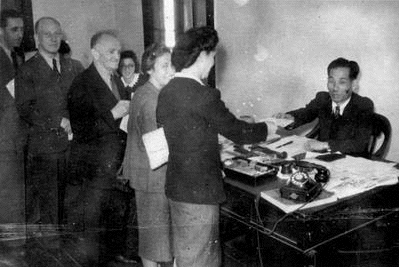
|
Jewish
Refugees in a Shanghai Government Office
[Source:
Yad Vashem Archive]
|
</www1.yadvashem.org/Odot/prog/image_into.asp?id=2532&lang=EN&type_id=2&addr=/IMAGE_TYPE/2532.JPG>
The Imperial Government of Japan
had allowed Jews to be welcomed in the late 1930s.
Between December 1937 and December 1939, three (3)
Far-East Asian Jewish conferences were held in Japan
planned by Dr. A. Kaufmann, leader of the Jewish
community in Harbin. Then, thereafter, free passage to
the Jewish refugees "was made a standing policy." (2nd
line, Block 4, ibidem).
Because of this policy, "many Jewish refugees were
admitted to Harbin and Dalian, and then went on to
America or Shanghai. (lines 3-5, Block 4,
ibidem).
Furthermore, when the Nazi Germany issued a protest
over the Jewish refugees in Japan, that protest was
ignored by the Japanese officials, (2nd ¶,
Block 4, ibidem)
and, to the contrary, a national Japanese policy to
protect the Jewish refugees began to emerge.
According to the exhibited
documentation, 1938 was a tumultuous year for Japan in
shaping its policy towards the Jewish refugees.
Nevertheless, on December 6, 1938, a Japanese
national policy of protecting Jewish refugees has been
formulated that was in direct disobedience to Japan's
allay, the Nazi Germany. (Block 5, ibidem).
As a result of this national
policy of protecting Jews, in the following year, in
1939, "the unrestricted influx of refugees was causing
problems for the Shanghai Jewish community and Shanghai's
department of works." (Block 6, ibidem).
The Japanese government, in spite of these
difficulties, allowed the influx of the Jewish refugees
to Shanghai to continue.
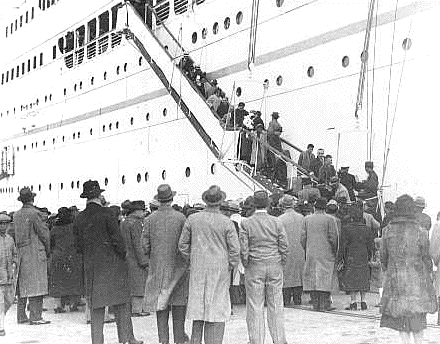
|
After
the Anschluss (German annexation of Austria),
Austrian Jewish refugees disembark from the
Italian steamship "Conte Verde." Shanghai,
December 14, 1938.
[United
States National Archives and Records
Administration]
<ushmm.org/wlc/media_ph.php?lang=en&ModuleId=10007091&MediaId=723>
|
|
.
|
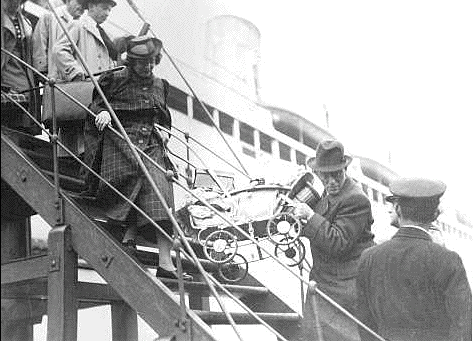
|
Jewish
refugees from Germany and Austria arrive at the
port of Shanghai,1938-1939.
[YIVO
Institute for Jewish Research, New York<
USA]
<ushmm.org/wlc/media_ph.php?lang=en&ModuleId=10007091&MediaId=843>
|
|
.
|

|
|
Two
German Jewish refugee women stand behind the
counter of the Elite Provision Store
(delicatessen) in Shanghai. Pictured on the left
is the owner, Gerda Harpuder; on the right is
her cousin Kate Benjamin. In 1939 Hans and Gerda
Harpuder sold their crystal, silver, and other
family possessions shipped from Berlin in order
to open a grocery store in Hongkew at 737 East
Broadway.
|
Ralph
Harpuder, United States Holocaust Memorial
Museum
<www.ushmm.org/wlc/media_ph.php?lang=en&ModuleId=10007091&MediaId=5305>
|
|
.
|
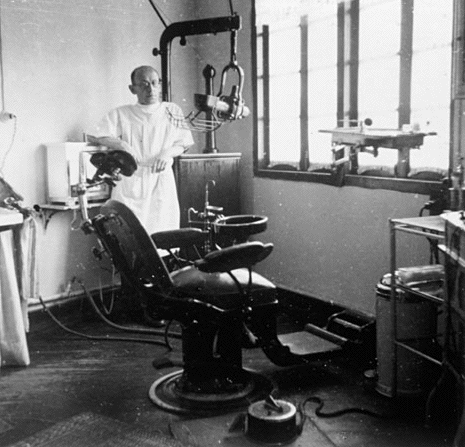
|
Dr.
Heinrich Mannes, a refugee dentist in
Shanghai
[John
and Harriet Isaack Collection, USHMM]
<ushmm.org/wlc/media_ph.php?lang=en&ModuleId=10007091&MediaId=5303>
|
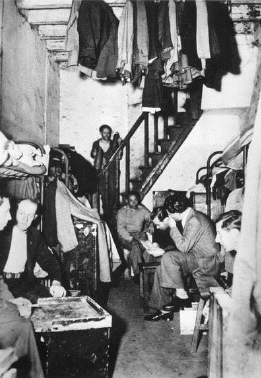
|
Jewish
Refugees from Europe in one of the 'Houses'
Established in Shanghai in the Early 1940's
[Yad
Vashem Archive]
|
<www1.yadvashem.org/Odot/prog/image_into.asp?id=2657&lang=EN&type_id=2&addr=/IMAGE_TYPE/2657.JPG>

The Myth of Chiune
Sugihara as Currently Portrayed
Chiune Sugihara, the Japanese
Vice-consul in Kaunas, Lithuania, is being credited with
the issuance of 2,139 family visas for the stranded
Jewish families during the period from July 29 to August
26, 1940. The myth that is being propagated worldwide
is:
- 1) that he, single-handed
acted against his Japanese government;
- 2) that he, has placed his
life in jeopardy as a result of his diplomatic
actions; and
- 3) that he, as a result of
those actions was dismissed from the Foreign
Service.
Based on these three combined
grounds, on October 10, 1984, Vice-consul Sugihara was
awarded the status of "Righteous
Among the Nations" by
the government of Israel trough Yad Vashem --The
Holocaust Martyrs' and Heroes' Remembrance Authority.
(Exhibit-Sugihara_YadVashem).
Getting the
History Right:
Evidence Contradicting the Yad Vashem Findings on
Sugihara
(with a Supplemental
Note***)
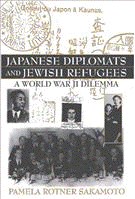 There
is perhaps massive prima facie evidence supporting
the finding that notwithstanding Japan's alliance with
Nazi Germany, Japan did not share nor became a partner in
Hitler's broad Anti-Semitic campaign. This buried
historic fact needs finally to surface in its full light.
There
is perhaps massive prima facie evidence supporting
the finding that notwithstanding Japan's alliance with
Nazi Germany, Japan did not share nor became a partner in
Hitler's broad Anti-Semitic campaign. This buried
historic fact needs finally to surface in its full light.
Some years ago, Pamela Rotner
Sakamoto in her 1998 book "Japanese
Diplomats and Jewish Refugees: A World War II
Dilemma" noted that the
pro-Jewish Japan appeared to have evolved not of a
particular pro-Jewish sentiment but rather because of the
rudimentary state of Japanese immigration policies and
poor coordination among various branches of the Japanese
government. That maybe so, but the new exhibited
documentation clearly brings a new element and dimension
that needs further be explored --that of the so-called
"Universal Brotherhood" imprinted in Japan's fabric by
its founding emperor Jinmu. This quotation from the
ending of Block 9 and begining of Block 10
(ibidem)
is perhaps most relevant for further study and
scrutiny:
|
.
|
|
.
Many people
of the time (especially military men)
thought of the words of the founding
emperor, Jinmu, after creating the state
of Japan: "Universal Brotherhood." This
great principle was behind all thought and
conduct.
.This
is why, when dealing deliberately with the
Jews who were in crisis at the time, it
was only natural that they did so
according to "Universal Brotherhood"
rather than being concerned about
"the Jewish peril."
.
Sugihara was
probably thinking about this when he said,
"As I was confronted by these wailing
Jewish refugees, what I thought was, 'what
would His Majesty do if he were here?'
When I thought that, the conclusion was
obvious. I had to do what I thought His
Majesty would have done."
|
All this background and context
does not fit the picture of Sugihara that is currently
being portrayed, as some sort of rebel acting alone
against his own government, but rather of a man of deep
conscience acting in the spirit of the founding emperor
Jinmu.
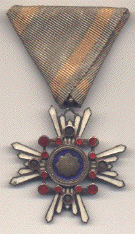
|
|
|
Sacred
Treasure 5th class
|
Also misleading is the representation of Yad Vashem that
Sugihara " when he returned to Japan in 1947, was asked
to leave the Foreign Service due to his act of defiance
in 1940" (Exhibit-Sugihara_YadVashem,
hereto). This simply is not true as supported by prima
facie evidence.
In 1947 Sugihara was no longer a
simple diplomat unrecognized by its own government, but a
distinguished Japanese diplomat as he, Chiune Sugihara,
on November 15, 1944, was awarded by his own
government with the Order of the Sacred Treasure
(Zuihosho), 5th-class for his diplomatic
services. (Block 5,
ibidem).
|
[Note: In
the NationMaster Encyclopedia under "Order of
the Sacred Treasure" at
<nationmaster.com/encyclopedia/Order-of-the-Sacred-Treasure>
and in the Wikipedia at
<en.wikivisual.com/index.php/Order_of_the_Sacred_Treasures>,
Chiune Sugihara is listed as one of the
recipients of this exact stated
medal.]
|
|
It is true that
Sugihara left the Foreign Service in 1947 as, on
that year, on June 7, he resigned his post. But
this was not, in any shape or form, due to his
diplomatic activities in Kovno, Lithuania, but
was because at that time Japan was under the
American control and administration. (Block 5,
ibidem).
This very point is also noted by the United
States Holocaust Memorial Museum on Sugihara
where it is stated (Ehibit-Sugihara_USHMM):
|
"When Sugihara
returned to Japan in 1947, the Foreign
Ministry retired him with a small pension as
part of a large staff reduction enacted under
the American occupation."
Uesugi Chitoshi, the
author of "Japan That Helped the Jewish
Refugees," concluded his exhibited posting
(ibidem)
with these lines:
"As an ally of
Nazi Germany, Japan cooperated militarily and
diplomatically, but definitely not with the
idea of anti-Semitism. The Japanese firmly
believed, and acted on, the spirit behind the
ideal of the founding of the Japanese state
of "Universal Brotherhood" -- that is, the
acceptance of Imperial will and acting in
accord with it was the active principal of
the Japanese people."
|
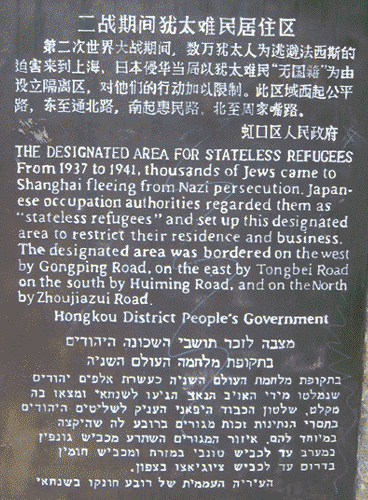
|
Monument
Commemorating Jewish Refugees Living in the
Hongkou District of Shanghai during WWII
[Source:
Yad Vashem]
<www1.yadvashem.org/education/lessonplan/english/Sugihara/Sugihara.htm>
|
Conclusion
Uesugi Chitoshi's conclusion
based on Japan's so-called "Universal Brotherhood," if
upheld by additional scholarly examination, will be able
to put perhaps a new dramatic light on Japan during its
terrible alliance with the Nazi Germany. In a contrasting
historic background, Japan's long standing hostility
towards China and its 1937 invasion of China (with its
subsequent 8-year brutal occupation of part of China)
needs also be examined in seeing how it can square and be
reconciled with Uesugi Chitoshi's "Universal Brotherhood"
doctrine. Chiune Sugihara, that remarkable man of
conscience and duty, was for sure a biproduct of
that complex and contradictory behavior of
Japan.
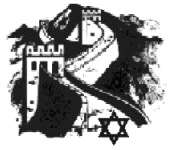 A
Chinese perspective on the matters presented herein can
be found from the Chinese History & Political Science
Professor, Dr. Pan Guang, Director and
Professor of Shanghai Center of International Studies and
Institute of European & Asian Studies in Shanghai,
Dean of Center of Jewish Studies Shanghai (CJSS), and
Vice Chairman of Chinese Society of Middle East Studies,
in his scholarly article entitled "Jews
in China: Legends, History and New
Perspectives."
A
Chinese perspective on the matters presented herein can
be found from the Chinese History & Political Science
Professor, Dr. Pan Guang, Director and
Professor of Shanghai Center of International Studies and
Institute of European & Asian Studies in Shanghai,
Dean of Center of Jewish Studies Shanghai (CJSS), and
Vice Chairman of Chinese Society of Middle East Studies,
in his scholarly article entitled "Jews
in China: Legends, History and New
Perspectives."
Also, we may want to mention in
here, that the United States Holocaust Memorial Museum in
its exhibit "Flight
and Rescue" has posted
these two (2) entries on Japan:
#1:
Japanese Policy Toward Jews
In
a late 1938 cable, the Foreign Ministry
informed its embassies that adopting an
anti-Jewish stance was not in Japan's
interests. Jews were to be treated like other
foreigners in matters of immigration to
Japan. The cable addressed the growing
refugee problem. In fall 1938 Jews fleeing
Nazi persecution were besieging Japanese
consulates in Vienna, Berlin, and other
cities of the Reich, seeking certificates to
enter Shanghai, then part of the Japanese
Empire, and visas for transit through Japan
to other destinations.
"It
is pivotal for the Empire's diplomacy to
maintain close friendly relationships with
Germany and Italy under the present
circumstances. We should as a rule avoid
actively embracing Jews who are being
expelled by our allies, but to radically
expel Jews as Germany has done is not in
keeping with the spirit of the Empire's
long-standing advocacy of racial equality. It
also would bring extremely unfavorable
results in the progress of the war effort
under the emergency situation that confronts
the Empire at the present, especially the
need to invite foreign capital for economic
development and to avoid any further
deterioration of relations with the United
States."
|
|
Source:
USHMM --
<ushmm.org/museum/exhibit/online/flight_rescue/exhibition_en_05.php>
|
  
|
#2:
Help from Kobe's Jewish
Community
With
the consent of Japanese authorities, a
representative of the Jewish community in
Kobe met the now-destitute refugees upon
their arrival in Tsuruga and accompanied them
on the train to Kobe. Using funds largely
from the American Jewish Joint Distribution
Committee, the Jewish community, led by
Anatole Ponevejsky, set up group homes,
arranged for housing and food, and interceded
on the refugees' behalf in dealings with
local officials.
|
|
--
<ushmm.org/museum/exhibit/online/flight_rescue/exhibition_en_07.php>
|
that, in essence, support completely Uesugi Chitoshi's
detailed documentation exhibited herein.
Finally, also perhaps of
interest, for additional research, is the examination of
the Soviets' role in this complex visa scheme upon the
annexation of Lithuania as part of the Molotov-Ribbentrop
Pact. Why did they
agree to give exist visas to the stranded Jewish refugees
holding a Sugihara visa? In the article
"Polish
Jews in Lithuania: Escape to
Japan" (posted at the US
Holocaust Memorial Museum), it is noted, and we
quote,
"...hundreds
of Jewish refugees applied for Soviet exit
visas. It remains unknown why the Soviets
allowed refugees with Polish travel papers,
many of dubious validity, to leave."
|
|
However in
"Born
In Kovno"
webpage, we have a number of accounts from
Holocaust survivors fostering the view that the
Soviets, upon annexing Lithuania, viewed the
Jewish refugees in transit therein as
"undesirable elements" and thus, the Soviets
were glad to give them an "exit visa" as soon as
possible.
|
Oh, that no good Jews
...
Respectfully
submitted,
K.
K. Brattman
Managing
Editor
Dated: December 31, 2007.

.
***
Editor's Supplemental Note:
From Japan and Lithuania, we found two
additional credible sources challenging Yad
Vashem's findings on
Chiune Sugihara
|

|
The
webpage of the Ministry of Foreign
Affairs of Japan entitled
"Story
of a Courageous Diplomat of
Humanity, Mr. Chiune
Sugihara"
at
<http://www.mofa.go.jp/region/middle_e/israel/sugihara.html>
supports completely the more
detailed analysis of the
exhibited
material
presented by Uesugi Chitoshi. In
particular, we note this paragraph
posted therein:
|
"After
the Japanese Consulate in Kaunas
was closed as a result of
Lithuania's annexation to the
Soviet Union, Sugihara served at
the Consulate General in Prague,
the Consulate General in
Königsberg and the Legation
in Romania. "The Order of the
Sacred Treasure, Gold and Silver
Rays" was conferred upon him by
the Japanese Government in 1944,
before he finally returned to
Japan in 1947 and left the
Ministry of Foreign
Affairs."
|

|
In
the webpage of the Lithuanian Global
Genealogical Society, point 8
entitled "Sugihara
Foundation --Diplomats for
Life"
at
<http://www.lithuaniangenealogy.org/labas/december.html#8>,
we can find this paragraph:
|
"The
Japanese Consul Sempo (Chiyune)
Sugihara lived in Kaunas
1939-1940. Transit visas, which
he issued contrary to the wishes
of the Japanese government, saved
the lives of thousands of
Lithuanian, Polish, and even
German Jews. After he returned
back to Japan in 1947, he retired
from the Ministry on his own
will. However, until the time of
retirement he was given rises in
salary and a decoration was
conferred on him. Mr. Chiune
Sugihara was also paid a
retirement allowance and pension.
In 1984, that is the year before
his death, Yad Vashem recognized
Semo Sugihari as 'Righteous Among
Nations.' The Japanese government
recognized his service in 1992,
and in the same year Sugihara's
city Yaotsu opened a memorial.
Japanese Prime Minister Noburu
Takeshita and other official
dignitaries participated in the
ceremony."
|
that
also supports in part Uesugi
Chitoshi's study exhibited
herein
and, contradict and challenge
Yad Vashem's findings.
.
|
.
|
.